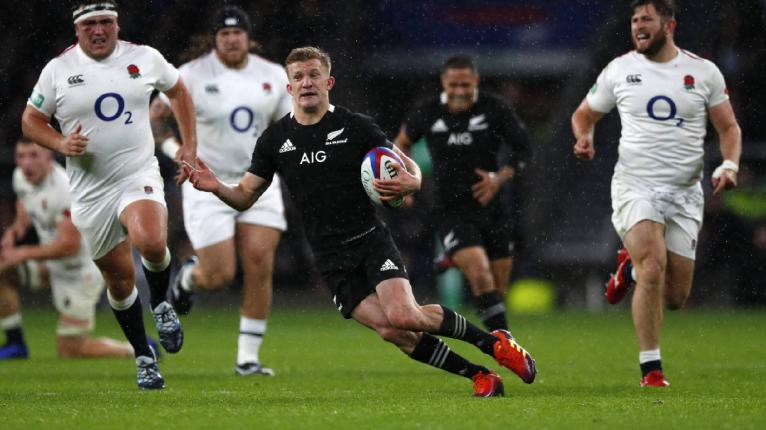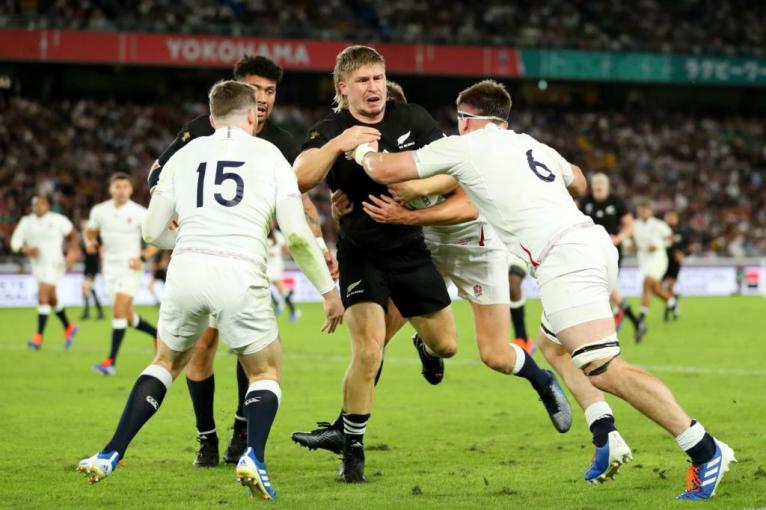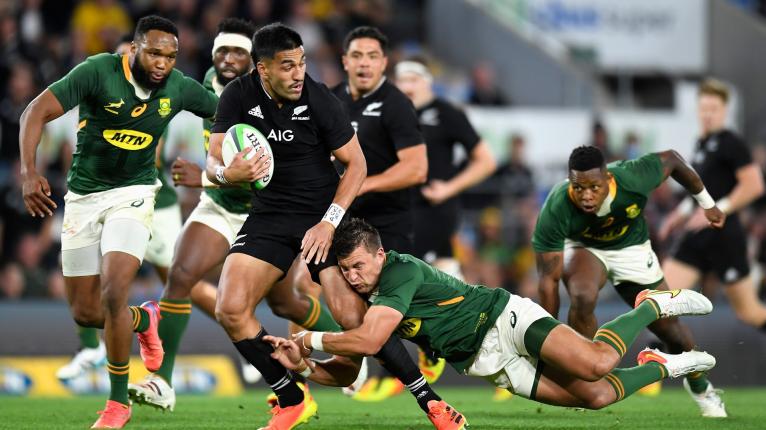With just a handful of games left to play between now and the Rugby World Cup, it’s fair to say that the time for experimentation is largely coming to a close.
In New Zealand’s case, that means the All Blacks side selected by Ian Foster to take on the Springboks at Ellis Park and effectively defend his position as head coach is likely to very much resemble the team that will be named to take on France in the opening match of the 2023 tournament.
There are, of course, a few exceptions.
You can never rule out a World Cup bolter or two – particularly in the outside backs where it often takes less time to become embedded in systems. Nehe Milner-Skudder was barely on the radar in 2018 but one year later, he was touching down for a try in the World Cup final.
Late-game injuries will also play a major part. After all, Damian McKenzie was expected to play a big role for the All Blacks at the 2019 tournament but an ACL injury during that year’s Super Rugby campaign with the Chiefs saw him sidelined for the remainder of the year.

The return of some men from injury could also upset the apple cart somewhat.
Midfielder Anton Lienert-Brown underwent shoulder surgery in April and is due to make a return to the field in the coming months. Given the 56 Tests to his name, Foster will struggle to leave Anton Lienert-Brown out of the first-choice line-up when he eventually finds his way back onto the field.
“I think he’s coaching the [Waikato] backs at the moment,” Foster recently said when asked to give an update on Lienert-Brown’s progress. “I had a look at him in his suit during one of the media things and I thought, ‘Maybe it is time he got back to training.’
“He’s ready to up the ante in that space. Medically, there’s a pretty good chance he could make the Northern Hemisphere tour.”
Given the 56 Tests to his name, Foster will struggle to leave Anton Lienert-Brown out of the first-choice line-up when he eventually finds his way back onto the field.
One man who’s unlikely to be available for that tour, however, is Jack Goodhue.
Having spent 12 months out through injury, Goodhue made his return to action halfway through this year’s Super Rugby Pacific season and quickly slotted into the Crusaders midfield. Goodhue was an unsurprising selection in Foster’s first All Blacks squad of the year but he wasn’t asked to suit up against Ireland in July and subsequently missed the trip to South Africa – ostensibly to clock up some much-needed game time with Northland in the NPC.
After two weeks of suiting up for the Taniwha, however, there will be no fairy-tale return to the All Blacks midfield just yet, with Goodhue now set to have further knee surgery.
“It wasn’t a setback from the weekend, he was just playing with a niggly knee,’’ Foster told media on Monday. “So he has come through that, there is still a lot of swelling. So they have assessed that, and it looks like it is going to be a knee tidy-up going on there.”
While Foster couldn’t provide a timeframe on when Goodhue would once again be fit, it would be a surprise to see the 27-year-old back in action for Northland anytime in the near future and without regular minutes under his belt, a position on the All Blacks’ end-of-year-tour looks increasingly unlikely.

If Goodhue was a 40-cap veteran with a robust resume of Test rugby under his belt, that wouldn’t necessarily be a major blow to the All Blacks’ World Cup ambitions. The likes of Ma’a Nonu and Conrad Smith both suffered their own setbacks throughout their careers but were fit when it mattered – in time for the 2011 and 2015 Rugby World Cups, and the coaches were able to bank on their considerable experience when push came to shove.
Goodhue, however, has struggled to put any considerable body of work together over the better part of the last five years and while everyone could see the potential class and poise he could bring to the midfield from an early age, he’s never been able to regularly prove that at Test level. With NZ likely to play just five or six games in 2023 in the lead-up to the World Cup, that likely won’t give Goodhue enough time to push for selection, effectively putting an end to his chances of featuring at the flagship tournament for the second time in a row.
It was Lienert-Brown and Goodhue who partnered up in the midfield during the knockout stages of the 2019 event in the No 12 and No 13 jerseys respectively and Foster would have undoubtedly held out hopes that the two could again combine in 2023 – even if a jersey swap may have been on the cards.
While David Havili and Rieko Ioane have been the preferred midfield combination throughout 2022 so far, neither player is a natural midfielder, unlike both Lienert-Brown and Goodhue. There’s also still a stark lack of synergy between the combination as was on full display in the victory at Ellis Park. Yes, both Havili and Ioane played well individually, but they struggled to link up as a partnership and their best work was done when they weren’t relying on the other to create or finish opportunities for them.
Jordie Barrett, Braydon Ennor and Roger Tuivasa-Sheck have all received some token minutes at inside and outside centre this season but like Goodhue, they’re also running out of time to actually prove their worth in the midfield.
With the World Cup coming up next year, however, the other options available to the All Blacks are limited.
Jordie Barrett, Braydon Ennor and Roger Tuivasa-Sheck have all received some token minutes at inside and outside centre this season but like Goodhue, they’re also running out of time to actually prove their worth in the midfield, given their limited exposure to the roles to date.
Quinn Tupaea is the only midfielder in the squad other than Havili or Ioane who’s been handed a starting opportunity and perhaps has provided the best individual performance we’ve seen at No 12 this season in the opening Test of the campaign – although things unravelled in the second fixture.
Foster has made it relatively clear, however, that with the current crop of players available, the Havili-Ioane combination is the preferred option, and that likely means sticking with it until Lienert-Brown returns to the fold. At that point in time, how will Foster accommodate for the 27-year-old? Does Ioane shift back onto the wing, does Havili drop to the bench or does Lienert-Brown come into the team as a bench specialist?

Lienert-Brown is a supremely talented player with an offloading game that can help unlock even the stiffest of defences and has spent ample time in both the No 12 and No 13 jerseys for the All Blacks but it’s in the latter role that he’s vastly better suited and that could see a significant rejigging of the backline. Perhaps his Chiefs teammate Tupaea comes back into the mix at that point – because a combination of Havili and Lienert-Brown perhaps doesn’t boast enough power to compete with some of the more sizeable midfields doing the rounds.
Even with a number of players effectively removed from the equation – Goodhue, Tuivasa-Sheck, Barrett and any other men who have yet to crack the New Zealand national squad – the midfield still remains a puzzle for the All Blacks, one that’s remained ever since Ma’a Nonu and Conrad Smith called time on their international careers following the 2015 Rugby World Cup.
There’s still time for Ian Foster to get things right – and perhaps Joe Schmidt’s elevation to attack coach will help matters – but the clock is very much ticking as France 2023 looms on the horizon.


I don't recall the All Blacks playing in the World Cup final in 2019. But that bit of hubris aside, the biggest problem the All Blacks have had in each of the last four tests they have played is mid-field defence. The Irish ran through the midfield at will, even when they beat the Springboks in the second test, when Willemse moved to inside centre he toyed with the midfield defence. Have look at the excellent analysis of Willemse's influence by Nick Bishop elsewhere on this platform. The defensive alignment of the AB's centres is diabolical. The outside centre (No13 to our Antipodean cousins) is critical in defensive alignment. South Africa's renown defence has been built round outstanding centres like Japie Mulder, Jacques Fourie and Lukanyo Am. The AB inability to find a permanent centre pairing built round the No 13 not the No12 as they are won't to do, is the key to midfield defence. If the AB's don't get that right very soon they are in for another long wait for WC glory.
Too much focus on "x factor" on attack, which ironically has come to nothing, over players who can actually play outside centre effectively. Ioane's glaring problems have been overlooked for years because he occasionally does something brilliant which he would be able to do even better with 11 on his back